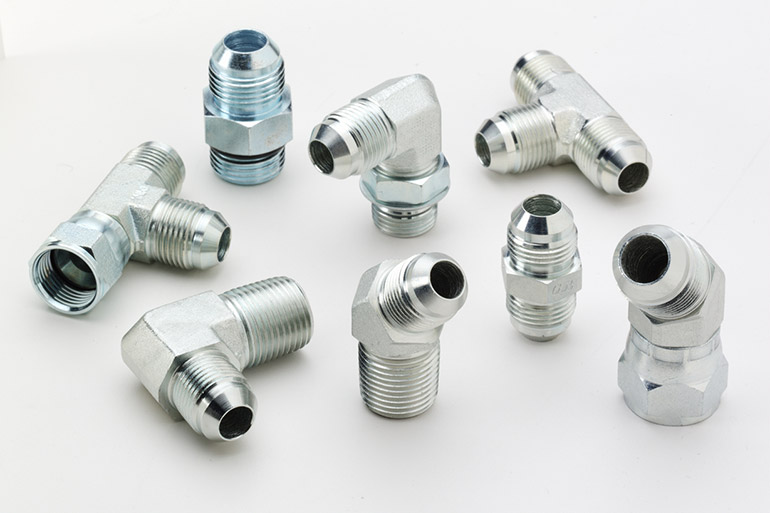
Professional hydraulic fittings supplier, Hydraulic industry service provider
16 years of professional experience in the production of hydraulic fittings: +86-18146260243 : sales06@hifitting.com

Professional hydraulic fittings supplier, Hydraulic industry service provider
16 years of professional experience in the production of hydraulic fittings: +86-18146260243 : sales06@hifitting.com
Improper selection or improper use of hoses, tubing, fittings, and assemblies can result in machine failures, leaks, personal injury, or even property damage if the failure is catastrophic. Understanding your plumbing standard chosen for your hydraulic system, and following the generally accepted installation standards reduces the chance of failure and prevents productivity-sapping machine downtime.
Engineers, designers, and technicians looking to specify plumbing for fluid power systems need to consider a few things besides correct size. You need to consider if the hose end fittings will be reused or permanent? What fitting standard will be on the machine? What hose was chosen or required for the machine.

Hydraulic hose ends are offered in two styles: permanent and reusable (also known as field attachable ends). Permanent hose ends are crimped on using special machinery, and the “teeth” within the housing and stem clamp hard on those hose, preventing removal through any method this side of a saw blade.
Reusable hose ends require the technician to first install the ferrule, which uses a left-handed thread that bites down on the hose’s cover. The technician then installs the socket, which threads traditionally but into the female threads on the outer end of the ferrule. Because the two thread opposite directions, tightening of the socket does not loosen the ferrule — in fact, the assembly just gets tighter.
There is a limitation to the pressure holding capacity of reusable hose ends, but they’re suitable for average working pressures. They’re installed using a vice to clamp the ferrule while a requisite wrench or socket wrench torques the socket home. No special equipment is required next to simple hand tools, although an impact wrench or air ratchet makes for quick work.
Crimped hose ends are permanent because the ferrule is deformed as the crimping tool crushes it to the manufacturers specified outside diameter. The teeth in the ferrule clamp into the hose’s cover right down to the reinforcement. Sometimes swaging is required using specialized equipment, which is the process of removing the outer carcass, although the practice is more often seen as redundant and obsolete.

There are three common types of coupling interfaces used in hydraulics today: thread interface, mated angle, and O-ring. Each design has its own method of sealing, each vastly different, and some better than others.
Threaded couplings have two constructions of thread: male (outside threads) and female (inside threads). The National Pipe Tapered thread, as the name implies, is manufactured with a tapered thread angle. When the male and female components are threaded and torqued together, the tapered threads apply pressure upon one another and deform- the flanks to create a seal.
Mated angle couplings form a seal when the male and female threads are screwed together and the seat and face are compressed. Two types of mated angle seals are SAE 45° and JIC 37°, although there are other standards. In the hydraulic realm, the JIC standard is the most popular because of its easy to install and reliable nature.
Fittings with angled seats for sealing have straight (parallel) threads. The threads themselves do not seal fluids as with tapered threads. Instead, the threads function to mechanically bring the two mating angle seats together through the mechanical advantage of the thread.
National Pipe Straight Thread Mechanical Joint (NPSM) brings two 30° tapered seats together to make the seal while employing the NPT thread. SAE 45° flare couplings are used on lower pressure applications, such as fuel lines, hot oil lines or refrigerant lines, but are rare in hydraulics. JIC 37° angle seats are used on medium-pressure and high-pressure lines on heavy equipment to join hydraulic hose assemblies to hydraulic system components.

O-ring designs are the pinnacle of high-pressure sealing, and there are three common types of O-ring seal designs — O-ring boss, flat-face, and O-ring flange. In the boss design, straight threads torque the fitting into the port and encapsulates the O-ring inside of the machined groove.
With the flat face fitting, the O-ring resides within a machined groove on the male’s face, and the compression of the threads provides a positive seal between the connection. The solid male O-ring face seal fitting will mate only with a swivel female O-ring face seal fitting.
O-ring flanges such as the SAE Code 61 and Code 62 style make high-pressure, large-diameter connections. A port is bored with a center outlet, and is surrounded by a smooth, flat face for the seal to interface, and uses four tapped holes to fix the four mounting bolts tight onto flange clamps. There are no threads on this coupling besides the four bolt holes, while the flange itself has the groove for the O-ring to reside and seal.
When specifying a hydraulic hose end, you must consider the following criteria:
PREVIOUS:What are the different standards for metric hydraulic fittings?